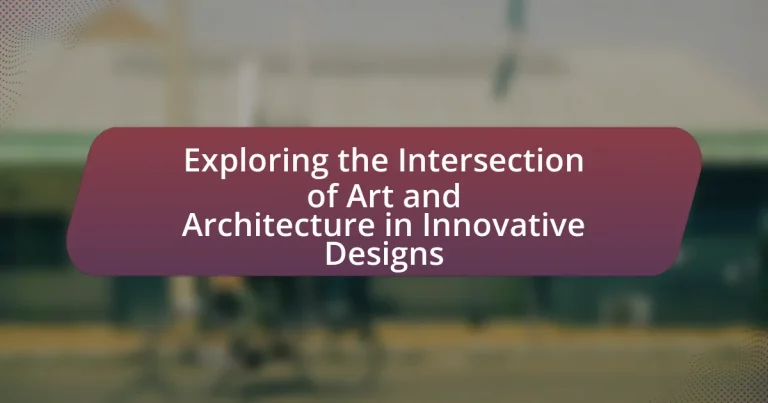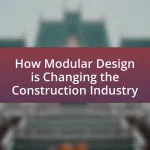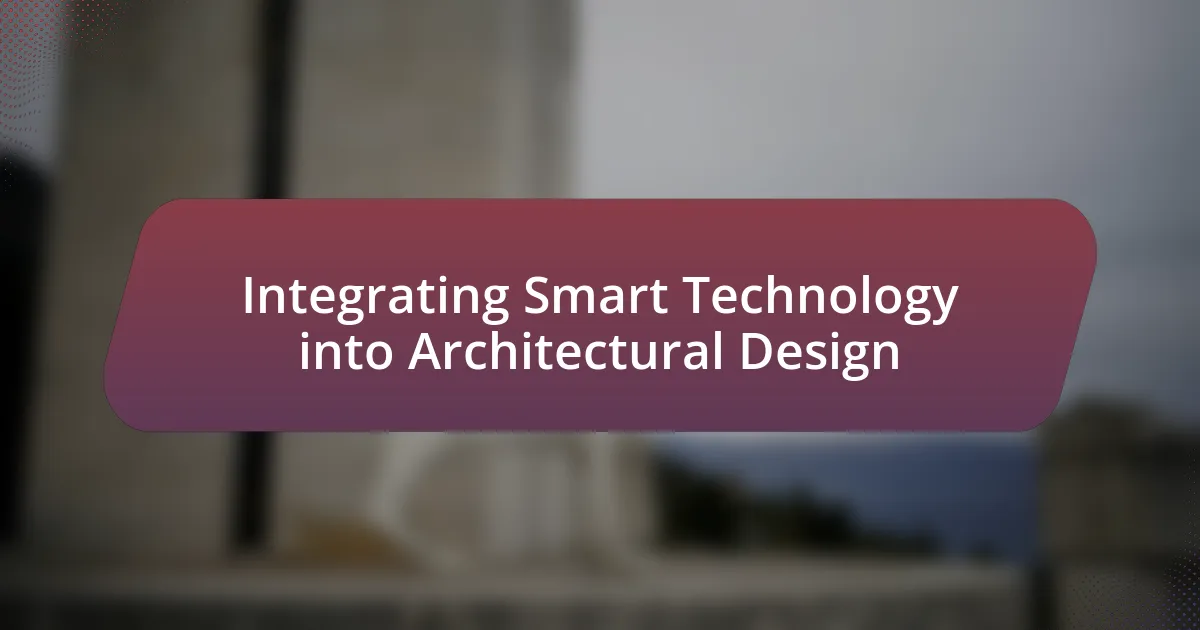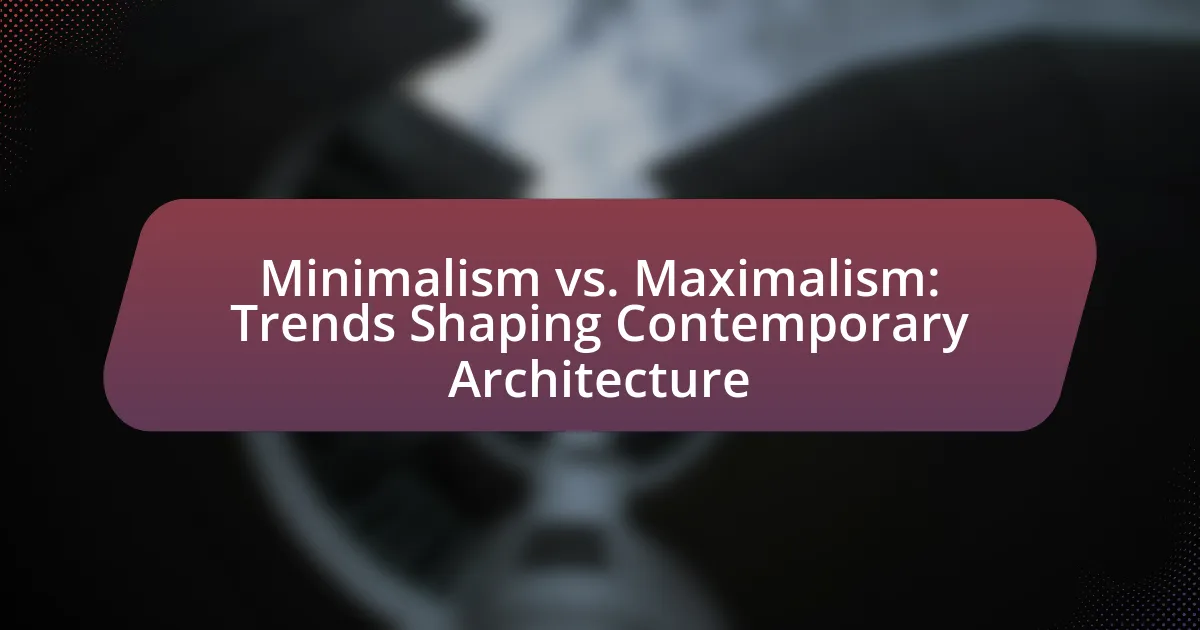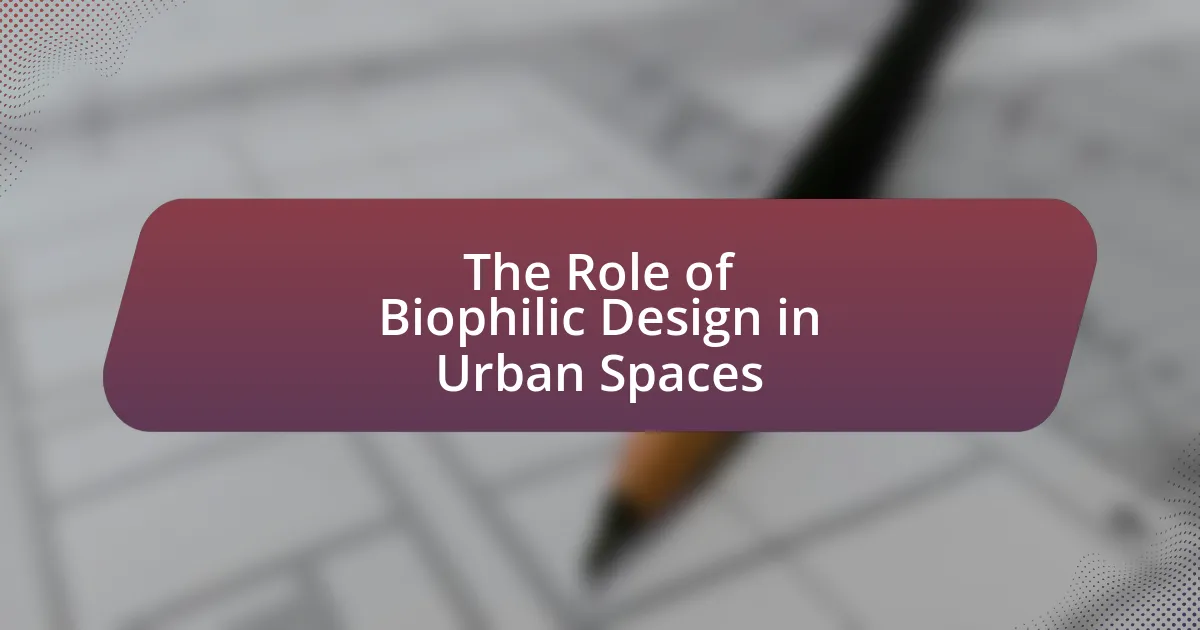The article explores the intersection of art and architecture in innovative designs, highlighting how their integration enhances both aesthetic appeal and functionality in built environments. It examines the mutual influence of art and architecture, historical examples of artistic movements shaping architectural styles, and the role of contemporary art in modern practices. Key elements such as creativity, sustainability, and cultural context are discussed, along with the challenges and opportunities presented by merging these disciplines. The article also emphasizes the importance of community engagement and the potential for sustainability in art-architecture collaborations, providing best practices for successful integration.
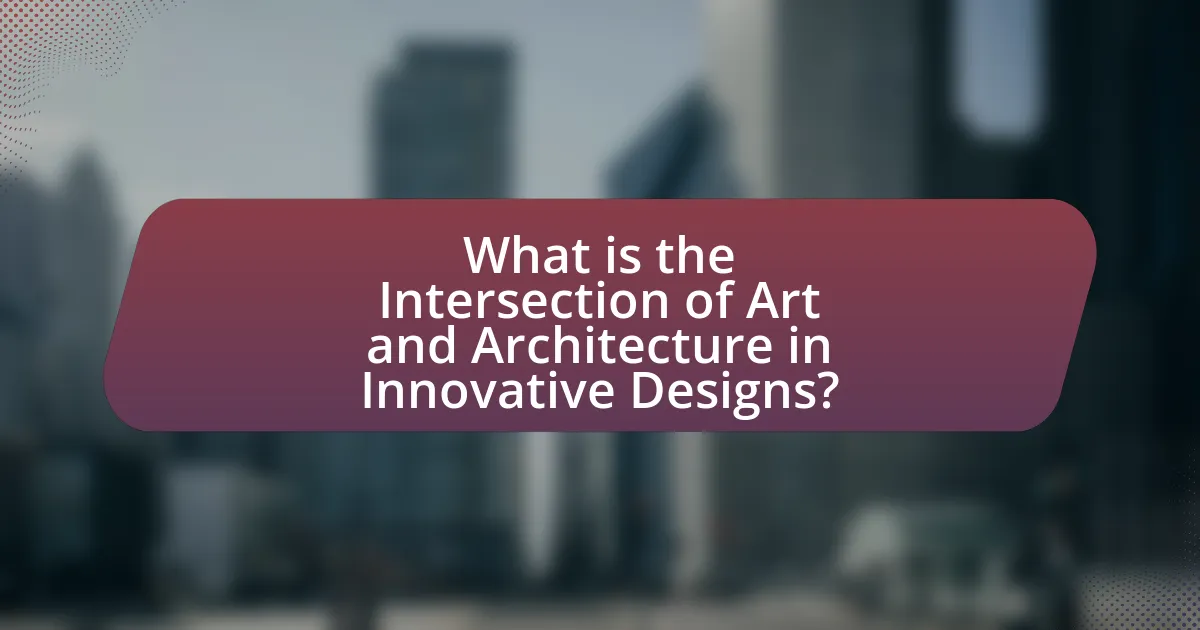
What is the Intersection of Art and Architecture in Innovative Designs?
The intersection of art and architecture in innovative designs is characterized by the integration of aesthetic expression and functional space. This synergy allows architects to create structures that are not only utilitarian but also visually compelling, enhancing the experience of the built environment. For instance, the Guggenheim Museum in Bilbao, designed by Frank Gehry, exemplifies this intersection by merging sculptural forms with practical space, resulting in a landmark that attracts millions of visitors and revitalizes its urban context. This collaboration between artistic vision and architectural principles fosters creativity, leading to groundbreaking designs that challenge conventional boundaries and redefine how spaces are perceived and utilized.
How do art and architecture influence each other in design?
Art and architecture influence each other in design through the integration of aesthetic principles and functional considerations. Architectural designs often draw inspiration from artistic movements, incorporating elements such as color, form, and texture to create visually compelling structures. For instance, the use of modernist art principles in architecture, as seen in the works of Frank Lloyd Wright, demonstrates how artistic concepts can shape spatial organization and material selection. Conversely, architecture provides a canvas for artists, allowing them to express their creativity through installations, murals, and sculptures that enhance the built environment. This reciprocal relationship is evident in iconic structures like the Guggenheim Museum in Bilbao, where the architectural form itself is a work of art, showcasing how design can transcend mere functionality to evoke emotional responses.
What are the historical examples of art influencing architectural styles?
Historical examples of art influencing architectural styles include the Renaissance, where the revival of classical art led to the development of neoclassical architecture, characterized by symmetry and grandeur. The works of artists like Michelangelo and Raphael inspired architects such as Andrea Palladio, whose designs emphasized harmony and proportion, reflecting the artistic ideals of the time. Additionally, the Art Nouveau movement in the late 19th and early 20th centuries showcased the integration of organic forms and decorative arts into architecture, as seen in the works of Antoni Gaudí, whose Sagrada Família incorporates intricate artistic elements that redefine traditional architectural forms. These examples illustrate how artistic movements have directly shaped architectural practices, leading to innovative designs that merge aesthetic and structural considerations.
How does contemporary art shape modern architectural practices?
Contemporary art significantly influences modern architectural practices by encouraging innovative design approaches and fostering interdisciplinary collaboration. Architects increasingly integrate artistic concepts into their work, resulting in structures that prioritize aesthetic experience alongside functionality. For instance, the use of unconventional materials and forms, inspired by contemporary art movements, has led to iconic buildings such as the Guggenheim Museum Bilbao, designed by Frank Gehry, which exemplifies the fusion of art and architecture. This integration not only enhances visual appeal but also engages communities, as seen in public art installations that transform urban spaces, thereby reshaping the architectural landscape.
Why is the integration of art and architecture important?
The integration of art and architecture is important because it enhances the aesthetic value and functionality of spaces, creating environments that inspire and engage users. This synergy allows for a holistic approach to design, where artistic elements can complement architectural structures, leading to innovative and meaningful experiences. For instance, the Guggenheim Museum in Bilbao, designed by Frank Gehry, exemplifies how the artistic form of the building itself becomes a work of art, attracting millions of visitors and revitalizing the surrounding urban area. Such examples demonstrate that when art and architecture are combined, they can transform public spaces, foster community engagement, and elevate cultural significance.
What benefits does this integration bring to urban environments?
The integration of art and architecture in urban environments enhances aesthetic appeal, fosters community engagement, and promotes cultural identity. This synergy creates visually stimulating spaces that attract residents and tourists alike, contributing to economic growth. For instance, cities like Barcelona have successfully integrated public art into their architecture, resulting in increased foot traffic and tourism revenue. Additionally, such integration encourages social interaction and community cohesion, as public art installations often serve as gathering points for local events and activities. This approach not only beautifies urban landscapes but also enriches the cultural fabric of cities, making them more vibrant and livable.
How does it enhance the user experience in public spaces?
Innovative designs that integrate art and architecture enhance the user experience in public spaces by creating visually engaging environments that foster social interaction and emotional connection. These designs often incorporate elements such as sculptures, murals, and interactive installations, which not only beautify the space but also encourage people to engage with their surroundings. For instance, studies have shown that public art can increase foot traffic by up to 30%, as it attracts visitors and encourages them to linger longer in the area. This increased engagement leads to a sense of community and belonging, ultimately improving the overall experience for users in public spaces.

What are the Key Elements of Innovative Designs at the Intersection of Art and Architecture?
Key elements of innovative designs at the intersection of art and architecture include creativity, functionality, sustainability, and cultural context. Creativity drives unique expressions and forms, allowing architects and artists to push boundaries and explore new materials and techniques. Functionality ensures that designs serve practical purposes while enhancing user experience, as seen in projects like the Sydney Opera House, which combines aesthetic appeal with performance space utility. Sustainability focuses on environmentally friendly practices, such as using renewable materials and energy-efficient systems, exemplified by the Bosco Verticale in Milan, which integrates greenery into its structure. Cultural context reflects the integration of local heritage and identity into designs, as demonstrated by the Louvre Abu Dhabi, which merges traditional Islamic architecture with modern design principles. These elements collectively foster innovative outcomes that enrich both artistic and architectural landscapes.
What materials and techniques are commonly used in these designs?
Common materials used in innovative designs at the intersection of art and architecture include glass, steel, concrete, and wood. These materials are favored for their structural integrity, aesthetic versatility, and ability to create dynamic spaces. Techniques such as parametric design, 3D printing, and sustainable building practices are also prevalent, allowing for intricate forms and environmentally conscious solutions. For instance, the use of glass not only enhances natural light but also creates visual connections between indoor and outdoor environments, while parametric design enables architects to manipulate forms based on specific parameters, resulting in unique architectural expressions.
How do innovative materials contribute to artistic expression in architecture?
Innovative materials significantly enhance artistic expression in architecture by enabling new forms, textures, and functionalities. These materials, such as carbon fiber, self-healing concrete, and 3D-printed components, allow architects to push the boundaries of traditional design, creating structures that are not only visually striking but also more efficient and sustainable. For instance, the use of transparent aluminum in buildings can create unique light effects and visual connections with the environment, while smart materials can adapt to changing conditions, adding a dynamic element to architectural aesthetics. The integration of these materials has been exemplified in projects like the Eden Project in the UK, where geodesic domes made from innovative materials create a visually captivating and functional space.
What role do technology and digital tools play in this intersection?
Technology and digital tools are essential in merging art and architecture, facilitating innovative designs through advanced modeling, visualization, and collaboration. These tools enable architects and artists to create complex structures and artistic expressions that were previously unattainable, such as parametric design software that allows for intricate geometric forms. For instance, the use of Building Information Modeling (BIM) enhances project efficiency by integrating various design elements and improving communication among stakeholders. Additionally, digital fabrication techniques, like 3D printing, enable the realization of unique artistic features in architectural projects, exemplified by the works of architects like Zaha Hadid, who utilized these technologies to push the boundaries of design.
How do cultural contexts influence innovative designs?
Cultural contexts significantly influence innovative designs by shaping aesthetic preferences, functionality, and user experience. For instance, traditional Japanese architecture emphasizes harmony with nature, leading to designs that incorporate natural materials and open spaces, which contrasts with Western designs that may prioritize functionality and urban density. This influence is evident in the use of tatami mats and sliding doors in Japanese homes, which reflect cultural values of simplicity and flexibility. Additionally, cultural narratives and historical contexts inform design choices, as seen in the incorporation of indigenous motifs in contemporary architecture, which fosters a sense of identity and belonging. Such cultural elements not only enhance the visual appeal but also ensure that designs resonate with the intended audience, ultimately driving innovation that is both relevant and meaningful.
What are some examples of culturally inspired architectural artworks?
Examples of culturally inspired architectural artworks include the Sydney Opera House, which reflects Indigenous Australian culture through its sail-like design, and the Alhambra in Spain, showcasing Moorish architecture with intricate tile work and calligraphy. The Guggenheim Museum in Bilbao, designed by Frank Gehry, incorporates elements of Basque culture in its innovative forms. Additionally, the Lotus Temple in India symbolizes the Bahá’í faith and features a flower-like structure that resonates with local spiritual beliefs. Each of these structures embodies cultural narratives and artistic expressions, demonstrating the profound connection between architecture and cultural identity.
How do local traditions shape the fusion of art and architecture?
Local traditions significantly influence the fusion of art and architecture by embedding cultural values and historical narratives into design practices. For instance, in regions like Japan, traditional aesthetics such as simplicity and harmony with nature are reflected in both art forms and architectural styles, leading to structures that emphasize natural materials and open spaces. This integration is evident in the use of tatami mats and shoji screens, which not only serve functional purposes but also embody cultural significance. Furthermore, local craftsmanship, such as the intricate woodwork seen in Scandinavian architecture, showcases how regional techniques and materials shape artistic expression within architectural frameworks. These examples illustrate that local traditions are not merely decorative but foundational elements that guide the creative processes in art and architecture, ensuring that they resonate with the community’s identity and heritage.

What are the Challenges and Opportunities in Merging Art and Architecture?
Merging art and architecture presents both challenges and opportunities. The primary challenge lies in reconciling the differing objectives of art, which often prioritizes personal expression, with architecture’s focus on functionality and structural integrity. This can lead to conflicts in design priorities, as seen in projects like the Guggenheim Museum in Bilbao, where the artistic vision of Frank Gehry faced scrutiny regarding its practicality and cost.
Conversely, opportunities arise from this intersection, as innovative designs can enhance cultural significance and community engagement. For instance, the integration of public art in urban architecture can transform spaces, fostering a sense of identity and belonging. The High Line in New York City exemplifies this, where art installations within an architectural framework have revitalized the area, attracting millions of visitors and boosting local economies. Thus, while merging art and architecture poses challenges, it also opens avenues for creative expression and urban revitalization.
What obstacles do designers face when integrating art into architecture?
Designers face several obstacles when integrating art into architecture, including budget constraints, differing stakeholder visions, and regulatory limitations. Budget constraints often limit the scope of artistic elements that can be incorporated, as high-quality art can be expensive. Differing visions among stakeholders, such as architects, clients, and artists, can lead to conflicts regarding the design direction, making collaboration challenging. Additionally, regulatory limitations, such as zoning laws and building codes, can restrict the types of artistic expressions that can be realized in architectural projects. These factors collectively complicate the seamless integration of art into architectural designs.
How can budget constraints impact the artistic elements of a project?
Budget constraints can significantly limit the artistic elements of a project by restricting the materials, techniques, and overall scope of creative expression. When financial resources are limited, artists and architects may have to opt for less expensive materials, which can compromise the quality and aesthetic appeal of the final product. For instance, a study by the National Endowment for the Arts indicates that projects with tighter budgets often result in simplified designs and reduced artistic features, as creators prioritize essential functions over elaborate artistic details. This financial limitation can lead to a more utilitarian approach, ultimately affecting the project’s visual impact and cultural significance.
What regulatory challenges exist in public art installations?
Regulatory challenges in public art installations include zoning laws, permits, and compliance with safety and accessibility standards. Zoning laws can restrict where art can be placed, often requiring specific approvals from local authorities. Additionally, artists must obtain permits that may involve lengthy application processes and adherence to municipal guidelines. Compliance with safety regulations, such as structural integrity and public safety measures, is also essential, as failure to meet these standards can result in removal or legal action. These challenges can significantly impact the feasibility and timeline of public art projects.
What opportunities arise from successful integration of art and architecture?
Successful integration of art and architecture creates opportunities for enhanced aesthetic appeal, cultural expression, and community engagement. This synergy allows for the creation of spaces that are not only functional but also visually inspiring, fostering a deeper connection between individuals and their environment. For instance, projects like the Guggenheim Museum in Bilbao, designed by Frank Gehry, demonstrate how artistic architecture can revitalize urban areas, attracting tourism and boosting local economies. Additionally, integrating art into architectural design can promote social interaction and inclusivity, as seen in public installations that invite community participation.
How can innovative designs attract tourism and community engagement?
Innovative designs can attract tourism and community engagement by creating visually striking and functional spaces that resonate with visitors and locals alike. For instance, iconic structures like the Guggenheim Museum in Bilbao, Spain, have transformed their cities into cultural hubs, boosting tourism by 22% after its opening in 1997. Such designs often incorporate local culture and history, fostering a sense of pride and ownership among community members, which in turn encourages local participation in events and activities. Furthermore, interactive and sustainable elements in design can enhance visitor experiences, leading to increased foot traffic and community involvement in maintaining and promoting these spaces.
What are the potential for sustainability in art-architecture collaborations?
Art-architecture collaborations have significant potential for sustainability by integrating eco-friendly materials and practices into design processes. These collaborations can lead to innovative solutions that reduce environmental impact, such as using recycled materials, implementing energy-efficient systems, and creating designs that promote biodiversity. For instance, projects like the Bosco Verticale in Milan showcase how art and architecture can work together to enhance urban ecosystems while providing aesthetic value. Additionally, the incorporation of green roofs and living walls in architectural designs not only improves air quality but also contributes to energy conservation. Such examples demonstrate that the fusion of artistic vision and architectural functionality can yield sustainable outcomes that benefit both the environment and society.
What are Best Practices for Achieving Successful Art and Architecture Integration?
Best practices for achieving successful art and architecture integration include early collaboration between artists and architects, a clear understanding of the project’s vision, and the incorporation of site-specific elements. Early collaboration fosters a cohesive design process, allowing both parties to align their creative goals and ensure that the art complements the architectural vision. A clear understanding of the project’s vision helps in selecting appropriate artistic styles and materials that resonate with the architecture. Incorporating site-specific elements, such as local culture and environment, enhances the relevance and impact of the integrated design. These practices are supported by successful case studies, such as the integration of public art in urban developments, which demonstrate improved community engagement and aesthetic value.
How can collaboration between artists and architects be fostered?
Collaboration between artists and architects can be fostered through interdisciplinary workshops and joint projects that encourage creative exchange. These initiatives provide a platform for artists and architects to share ideas, techniques, and perspectives, leading to innovative design solutions. For instance, programs like the “Art and Architecture” initiative at the University of Southern California have successfully integrated art into architectural education, demonstrating the benefits of collaborative learning environments. Such structured interactions not only enhance mutual understanding but also result in projects that reflect a synthesis of artistic vision and architectural functionality.
What strategies can be employed to ensure community involvement in design processes?
To ensure community involvement in design processes, strategies such as participatory design workshops, surveys, and community advisory boards can be employed. Participatory design workshops actively engage community members in brainstorming and decision-making, allowing their insights to shape the design. Surveys can gather broader input from the community, ensuring diverse perspectives are considered. Community advisory boards provide ongoing feedback and representation, fostering a sense of ownership and commitment among residents. Research indicates that projects incorporating community input are more successful and sustainable, as evidenced by the 2018 study published in the Journal of Urban Design, which found that community-engaged projects led to higher satisfaction rates and better alignment with local needs.
